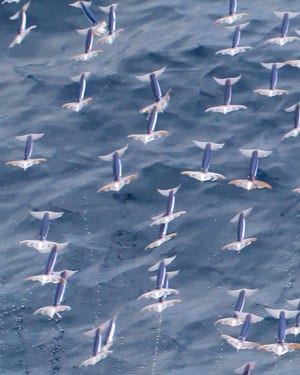Flying Squid (April 15)


Ancient sailors spin yarns of mermaids, sea monsters, giant octopuses, sunken cities, and flying squid. The mermaid stories are based on fanciful storytelling; however, the stories of flying squid, sunken cities, and giant octopuses have turned out to be absolutely true! As a matter of fact, squid have now been documented to soar as high as 20 feet above the ocean surface on flights of over 180 feet. So how do animals with no wings and bodies designed to swim manage to soar above the water’s surface? And more to the point, why would a squid bother to fly?
Each flight has three distinct phases:
- A sudden contraction of the squid’s body shoots water out of its funnel shaped rear end in a jet stream and propels them it the air.
- During flight, the squid spreads out his front fins like wings and arranges his rear tentacles in a fanlike pattern (not unlike the tail fins of a plane). This aerodynamic position allows him to glide long distances after the jet propulsion stops.
- He folds his fins and tentacles back against his body to end his glide with a controlled dive in order to minimize the impact and maximize the forward movement as he reenters the water.
Researchers have discovered that a squid’s jet propulsion moves it three times farther in air than the same exertion in the water. Thus by “flying,” a squid can travel much longer distances using far less energy. Evolutionists believe that squids evolved this ability to “fly” over millions of years, yet in the fossil record we see squids are squids (even though evolutionists have taught us the fossil ancestors are over 200 million years old).
The creativity and design of the squid’s jet propulsion testifies to the creativity and intelligence of its designer, not evolutionary development.
Psalm 47:7
KJV: For God is the King of all the earth: sing ye praises with understanding.
NIV: For God is the King of all the earth; sing to him a psalm of praise.
Reference
Catchpole, David. 2015. “Squid do…fly!”. Creation. 37(4) 12-13.
